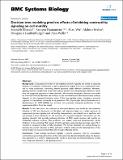Decision tree modeling predicts effects of inhibiting contractility signaling on cell motility
Author(s)
Kharait, Sourabh; Hautaniemi, Sampsa; Wu, Shan; Iwabu, Akihiro; Lauffenburger, Douglas A.; Wells, Alan; ... Show more Show less
Download1752-0509-1-9.pdf (1.882Mb)
PUBLISHER_CC
Publisher with Creative Commons License
Creative Commons Attribution
Terms of use
Metadata
Show full item recordAbstract
Background: Computational models of cell signaling networks typically are aimed at capturing dynamics of molecular components to derive quantitative insights from prior experimental data, and to make predictions concerning altered dynamics under different conditions. However, signaling network models have rarely been used to predict how cell phenotypic behaviors result from the integrated operation of these networks. We recently developed a decision tree model for how EGF-induced fibroblast cell motility across two-dimensional fibronectin-coated surfaces depends on the integrated activation status of five key signaling nodes, including a proximal regulator of transcellular contractile force generation, MLC (myosin light chain) [Hautaniemi et al, Bioinformatics 21: 2027 {2005}], but we have not previously attempted predictions of new experimental effects from this model. Results: In this new work, we construct an improved decision tree model for the combined influence of EGF and fibronectin on fibroblast cell migration based on a wider spectrum of experimental protein signaling and cell motility measurements, and directly test a significant and non-intuitive a priori prediction for the outcome of a targeted molecular intervention into the signaling network: that partially reducing activation of MLC would increase cell motility on moderately adhesive surfaces. This prediction was indeed confirmed experimentally: partial inhibition of the activating MLC kinase (MLCK) upstream using the pharmacologic agent ML-7 resulted in increased motility of NR6 fibroblasts. We further extended this exciting finding by showing that partial reduction of MLC activation similarly enhanced the transmigration of the human breast carcinoma cell line MDA-213 through a Matrigel barrier. Conclusion: These findings specifically highlight a central regulatory role for transcellular contractility in governing cell motility, while at the same time demonstrating the value of a decision tree approach to a systems "signal-response" model in discerning non-intuitive behavior arising from integrated operation a cell signaling network.
Date issued
2007-01Department
Massachusetts Institute of Technology. Department of Biological EngineeringJournal
BMC Systems Biology
Publisher
BioMed Central Ltd
Citation
BMC Systems Biology. 2007 Jan 29;1(1):9
Version: Final published version
ISSN
1752-0509